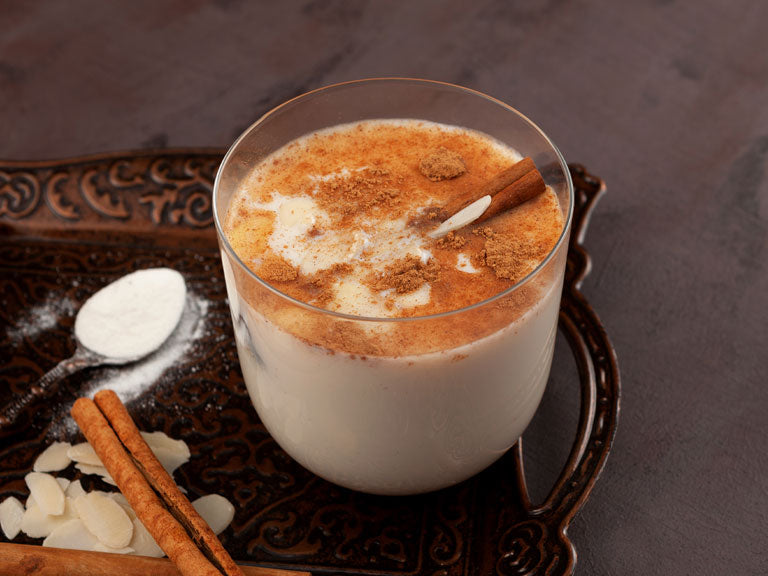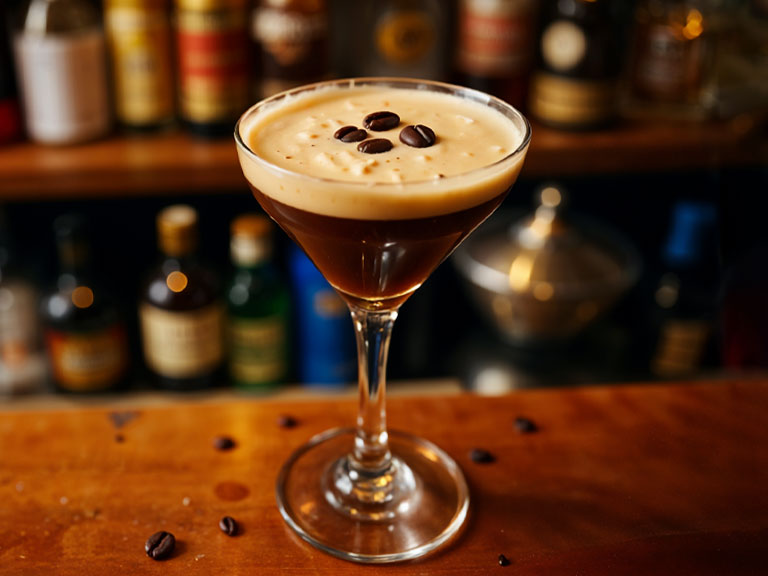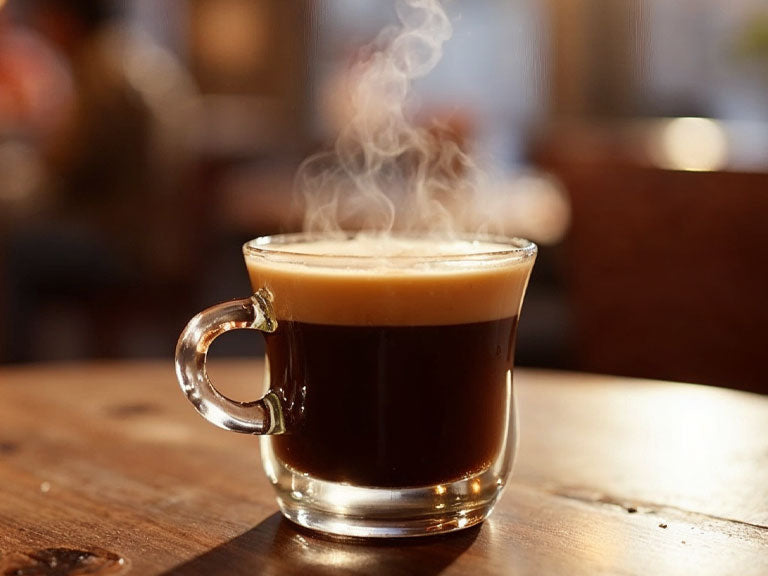Espresso Macchiato
The gentle coffee kick
The gentle coffee kick
When a wrong order
turns into a new coffee love
Have you ever waited in a café full of anticipation for a latte macchiato and then been served an espresso with a blob of milk foam instead of a brimming latte macchiato glass? First the surprised look, followed by the question of what it was and then the polite nod because you realized that you had accidentally ordered an espresso macchiato instead of a latte macchiato.
But maybe it wasn't such a bad mistake, but a fateful coincidence and the beginning of a new love affair. Because what awaits you in this small espresso cup is truly a small coffee highlight that is given far too little attention in Germany: an intense espresso, refined with a hint of creamy milk foam.
The unrecognized coffee pearl
Sometimes it's exactly these kinds of coincidences that bring us the best new discoveries and break through and enrich our routine everyday lives. Perhaps this supposed mistake has even given you a taste for the espresso macchiato? And if not, you'll be ready to add it to your coffee repertoire after reading this article.
We explain everything you need to know about the espresso macchiato - from its simple preparation to exciting details that will definitely increase your interest in this coffee variation.

What exactly is a
espresso macchiato?
In Italian, "macchiato" means "stained" or "stained". According to the translation, an espresso macchiato is therefore a "stained" espresso. This sounds somehow negative, but it is not at all what is meant. The name refers to the appearance of the espresso macchiato: in this preparation variant, the espresso is topped with a hint of frothed milk.
Looking at it from above, the espresso now looks "stained": The rich, brown crema is pushed to the edge of the cup by the milk foam. The milk foam is now centered in the middle of the espresso cup.

The milk foam cap gives the espresso a slightly creamy note without losing its characteristic intensity. This makes the espresso macchiato perfect for anyone who loves the pure taste of an espresso, but occasionally wants a slightly milder finish.
And it is also an excellent alternative for all coffee fans who generally find espresso too strong, but don't want to change the taste with too much milk.
The perfect espresso:
No coffee enjoyment without a solid base!
Before we explain how to make an espresso macchiato, let's first look at the basis - the espresso. Because without a really good espresso, even the best macchiato is only half as exciting.
An espresso is concentrated coffee in its purest form: hot water pressed through finely ground coffee beans at high pressure. Sounds simple at first, but it requires precision and great attention to detail. Anyone who has ever witnessed experienced baristas adjusting their coffee grinders and espresso machines to new coffee beans knows exactly how much dedication and precision work is involved.
The grind must be adjusted so that around 25-30 ml of water flows through the portafilter in exactly 25-30 seconds - not too fast to fully extract the flavor, but also not too slow so that no bitter substances dominate.
The weight of the coffee grounds in the portafilter also plays a decisive role: typically, 18-20 grams are used for a double espresso, but depending on the bean, this quantity can be adjusted slightly to achieve the perfect aroma.

Experienced baristas adjust their grinders millimetre by millimetre, taste the espresso again and again and evaluate the result in the cup until all parameters - grind, water flow and quantity, as well as extraction time - work together harmoniously. Even the pressure of the tamp, i.e. the pressure of the coffee grounds in the portafilter, influences the final result.
Too much pressure and the water flows too slowly, too little and the espresso becomes watery. Some baristas therefore also use a scale to apply the ideal pressure to the ground coffee. This perfection is not just pure technique, but true craftsmanship - and you can taste it in every sip.
How do you recognize a really good espresso
?
- Intense, multi-faceted taste
- Velvety-creamy texture
- Golden-brown, dense crema
- A volume of exactly 25-30 ml
- A perfect extraction time of 25-30 seconds
If you pay attention to these points, you have the ideal base for any coffee creation - and of course for an espresso macchiato.
The preparation - simple,
but with attention to detail
The preparation of an espresso macchiato is fairly simple and quickly explained.
Ingredients:
- A freshly brewed espresso or espresso doppio
- One tablespoon of frothed milk
Preparation steps:
- Prepare the espresso: Make a single or double espresso in an espresso cup. For the perfect taste, portafilter machines or very good fully automatic machines are best suited.
- Froth the milk: Froth the milk to a fine, creamy froth.
- "Stain" the espresso: Now carefully slide a spoonful of the milk foam onto the center of the espresso. Tadaá - your espresso macchiato is ready!
Video:
Tip:
Always preheat your espresso cups a little, otherwise the espresso will cool down too quickly and will no longer be able to fully reveal its complex and strong aromas.
Where does the espresso macchiato come from?
The origin of this little pick-me-up lies in Italy. Traditionally, the espresso macchiato was the choice of many Italians who wanted to enjoy their espresso a little softer without having to sacrifice the strong flavor.
This gave rise to the idea of adding a touch of milk to the espresso to make the intense flavor more digestible without changing the character of the espresso. Espresso macchiato is particularly popular in Italian cafés in the afternoon. This is because there is an unspoken rule in Italy: milk in coffee after breakfast is considered a no-go.
Italian tradition with a touch of milk foam
While cappuccino and latte macchiato are very popular in the morning, later in the day people prefer a variant that retains the pure espresso taste. However, as a strong espresso is too strong for some, or the second espresso should be a little milder, people like to fall back on an espresso macchiato.
With its hint of milk foam, it offers just the right balance between gentle mildness and strong intensity, without breaking the rules of Italian coffee culture. This small espresso macchiato is not only full of flavor, but also a deeply rooted Italian coffee tradition.

Good to know:
If you order "caffè" in Italy, you get espresso. So it should come as no surprise that espresso macchiato is often simply referred to as "caffè macchiato" there.
Espresso macchiato vs. latte macchiato
The most obvious difference between an espresso macchiato and a latte macchiato is the size or volume. An espresso macchiato is served in a small espresso cup and contains around 25-30 ml plus a touch of milk foam. Whereas a latte macchiato is served in a glass with a capacity of around 300-350 ml and plenty of milk foam.
Another rather inconspicuous difference is the order of preparation. For a latte macchiato, the frothed milk is poured into the glass first and once it has settled a little, the espresso is carefully poured in. For an espresso macchiato, the espresso flows directly into the espresso cup and the milk foam is simply placed on top at the end.
The differences at a glance
Espresso Macchiato
- Espresso with a touch of milk foam
- Intense flavor with a slightly creamy note
- Served in an espresso cup
Latte Macchiato
- Lots of hot milk with foam and an espresso
- Milky, with a gentle espresso note
- Served in a tall glass
Our tips for a
perfect espresso macchiato
The right milk foam: The milk foam should be fine-pored, creamy, then it glides easily from the spoon onto the espresso, blends a little with the crema at the edges and forms the typical "white spot" in the middle of the cup.
The choice of cup: Always prepare the espresso macchiato in a small, pre-heated cup and serve immediately. This keeps the espresso pleasantly hot and allows the aromas of the beans to fully come into their own.
Prepare with attention to detail: An espresso macchiato is more than just an espresso - it's a little ritual. Take the time to enjoy it.
Short facts about the espresso macchiato
Ingredients:
- Origin: Italy
- Caffeine content: High
- Taste: Intense, strong with a mild finish
- Preparation time: Maximum 5 minutes
- Best time of day: In the afternoon, as a little break in between
FAQ - Questions & answers about espresso macchiato
Conclusion
The espresso macchiato is a real all-rounder:
It combines the strength of an espresso with a subtle mildness and a velvety texture.
Perfect for a little energy boost in between meals or as an accompaniment to a sweet pastry - the espresso macchiato is a highlight for all coffee lovers who love the pure taste of an espresso and still want to enjoy a little bit of milk every now and then.




